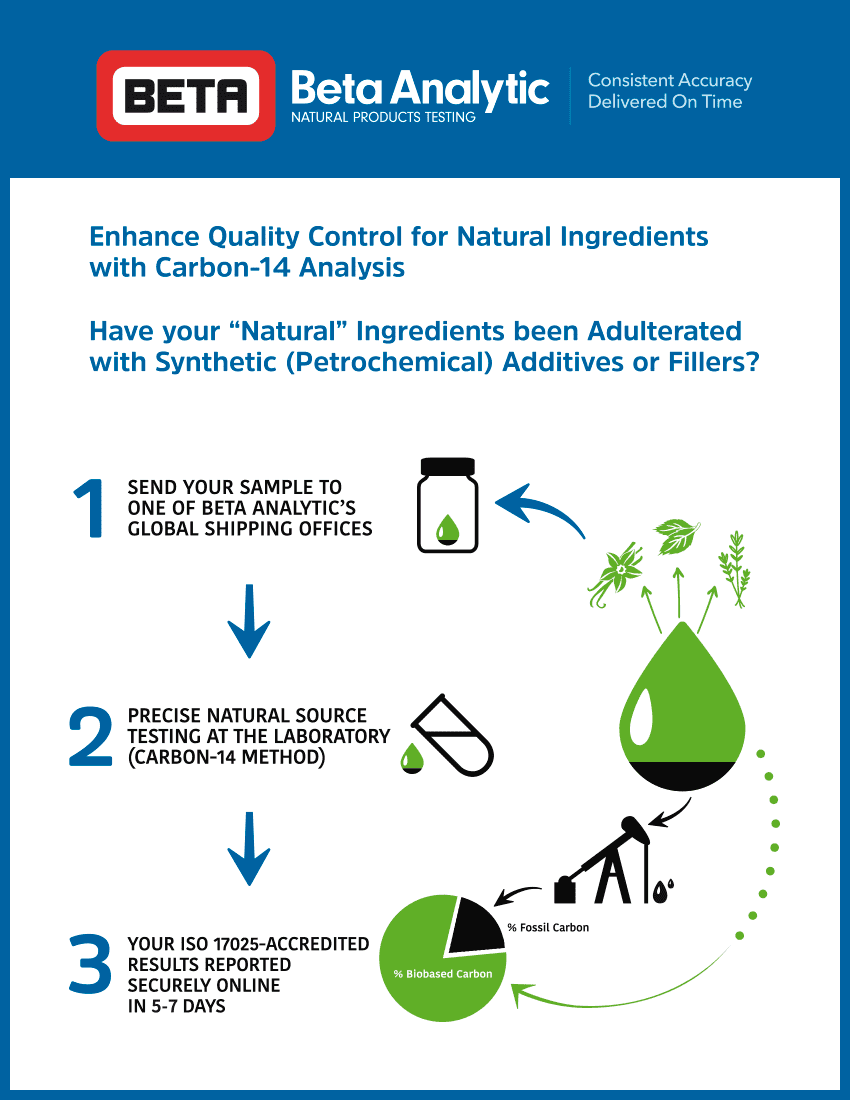Essential Oil Testing by Carbon-14 Analysis
 Essential oils are concentrated essences of plants extracted through distillation or pressing. They are used widely for their flavor, fragrance and even therapeutic effects. Given their wide range of applications and the increasing trend to favor “natural” products, there is great demand for essential oils in the pharmaceutical, cosmetics, food and drinks industries.
Essential oils are concentrated essences of plants extracted through distillation or pressing. They are used widely for their flavor, fragrance and even therapeutic effects. Given their wide range of applications and the increasing trend to favor “natural” products, there is great demand for essential oils in the pharmaceutical, cosmetics, food and drinks industries.
Essential oils are expensive to produce, and with their increasing popularity has come the more readily available synthetic versions often denoted as fragrance oil. The synthetic versions do not have exactly the same components as the naturally sourced oils. In the production of the natural essential oils, there are other compounds in low concentrations that are also extracted. For example, when synthesizing cinnemaldehyde, the other compounds found in the natural cinnamon oil are not created.
Biobased content testing (Carbon-14 analysis) determines whether the essential oil is natural or synthetic. Biobased content testing can be used by suppliers and manufacturers to verify if an essential oil has not been adulterated with the cheaper synthetic alternative. To distinguish between different natural sources, stable isotope testing or other chemical analyses are required.
Natural vs Synthetic Essential Oils
Bitter almond oil vs Synthetic Benzaldehyde
Bitter almond oil is used widely as a flavoring agent. In addition to almond kernels, bitter almond oil can also be extracted from fruits like peaches and apricots. Due to the limited supply and higher cost of the natural form, the synthetic compound is often used in food and drink products.
Biobased content testing can determine whether the bitter almond oil has been made from a natural or synthetic source or is a mixture of both. Biobased content testing, however, cannot distinguish between the different natural sources.
Cinnamon oil vs Synthetic Cinnamaldehyde
Cinnamon oil is used in the food industry as flavoring and fragrance, as a fungicide and for its health benefits. Cinnamon oil can refer to two types – the stronger and more expensive to produce cinnamon bark oil and the cheaper cinnamon leaf oil and cassia oil. Given the high production price, it is cinnamon bark oil that runs the higher risk of being adulterated with a cheaper alternative.
Biobased content testing can verify whether cinnamon oil is made from its natural source or if it has been adulterated with synthetic cinnamaldehyde.
Natural Linalool from Essential Oil vs. Synthetic Linalool
Linalool is a key constituent of coriander oil, which in its natural form is extracted from seeds of the Coriandrum sativum L. (C. sativum) plant. Linalool is also a component of bergamot, lavender, mentha citrata and rosewood oils. The aroma chemical is used in fragrance and flavoring, preservatives, lotions and therapeutic medicines.
Biobased carbon testing can identify petro-chemically derived synthetic linalool, which is chemically the same as linalool distilled from lavender oil, but it is not botanical in origin. Biobased carbon testing, however, cannot distinguish the specific botanical origin of natural linalool or identify synthetic linalool manufactured from beta-Pinene, a by-product of the paper industry.
Thyme Essential Oil vs. Synthetic Thymol
Thyme essential oil has many medicinal properties. It contains thymol which gives the essential oil its antiseptic properties. Synthetic thymol is used as an antiseptic in mouthwashes and in general purpose disinfectants among many other applications.
Biobased carbon testing can differentiate between thyme essential oil (thymol chemotype) extracted from plants such as those belonging to the Lamiaceae family and synthetic thymol, which can be manufactured in the lab with very high purity (99.9+%) from petrochemical sources at a low cost.
Natural products testing using the Carbon-14 method can be used to screen these essential oils if they contain petrochemical-derived adulterants.
| Essential Oil | Synthetic Adulterant |
| Bitter Almond Oil | Benzaldehyde |
| Cassia Oil | Cinnamaldehyde, Coumarin |
| Cinnamon Bark Oil | Cinnamaldehyde |
| Lemongrass Oil | Citral |
| Litsea Cubeba Oil | |
| Cumin Fruit Oil | Cuminaldehyde |
| Basil Oils | Linalool |
| Bergamot Oil | |
| Coriander Fruit Oil | |
| Mentha Citrata Oil | |
| Nutmeg Oil | |
| Rosemary Oil | |
| Rosewood Oil | |
| Peppermint Oil | Menthol, Mineral Oil |
| Wintergreen Oil | Methyl Salicylate |
| Origanum Oil | Thymol |
| Thyme Oil |
Beta Analytic’s Essential Oils Testing
ISO/IEC 17025:2017-accredited Beta Analytic provides fast, high-quality Carbon-14 analysis of essential oils. Results are reported between 7 business days or less. A priority service is available for results required in 4 business days or less.
The Miami-based lab reports results according to ISO 16620-2 (biobased carbon content as a fraction of total carbon or total organic carbon) or ASTM D6866. For inquiries, email or call the lab.
Related Topics:
- Carbon-14 Analysis Enhances Garlic Oil Quality Control
- How Carbon-14 Analysis Can Verify Natural Claims
- Natural vs Synthetic Menthol – How to Check for Adulteration
